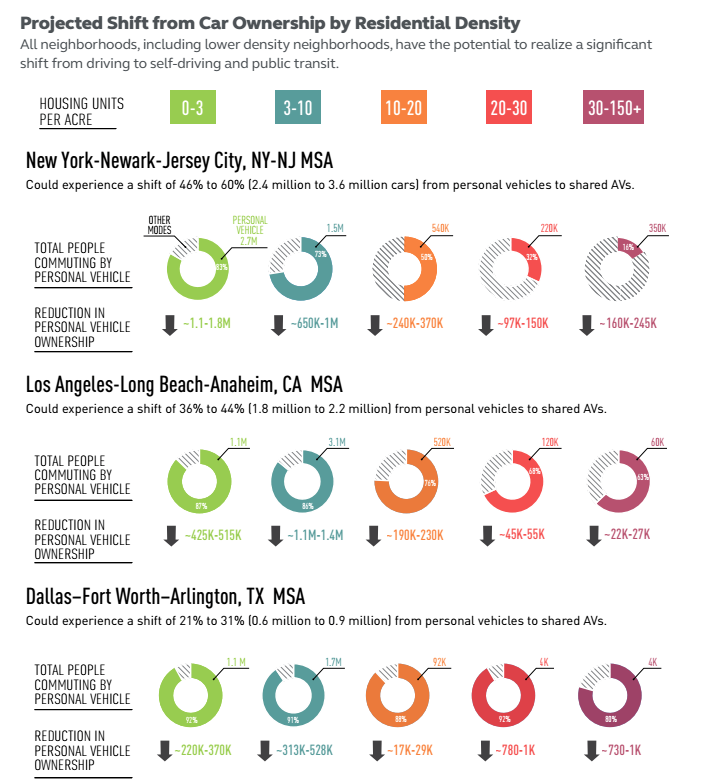Back in January, the U.S. Department of Transportation selected Texas as one of the 10 regions that would test out autonomic vehicles. “With five of the nation’s 15 fastest-growing cities in Texas and our population expected to potentially double by the year 2050, Texas must be a leader in new technology that addresses transportation challenges,” said Marc Williams, deputy executive director of the Texas Department of Transportation in a statement.
The program will help guide the creation of safety regulations for the new technology. But before autonomous vehicles take to the roads here, policymakers should take specific steps to plan for their integration, according to a new report. With more drivers likely to switch from owning and driving their own cars to driverless ride-sharing services, cities risk increased congestion, the study argues. But with the right policies in place, cities could actually alleviate traffic, spur the mixed-use development that most Americans say they want and strengthen access to jobs and services for all residents.
"Public policy will play a decisive role in shaping AV technology and guiding its impact on cities, as it did during past technological revolutions involving the railroad, the streetcar, and the automobile," notes the report, co-authored by three high-profile design, planning and development firms; Arcadis, Inc., HR&A Advisors, Inc. and Sam Schwartz Consulting, LLC. "Cities that do nothing face major risks."
Assuming that ride-sharing services using driverless technology -- Uber has already started testing out its technology on city streets -- will represent an increasing share of cars on the road, the report says this shift could be "highly disruptive" for many cities, as fewer people own or drive their own cars.
Some of the biggest gains in shared usage could actually be seen in suburban areas. "Most of the transition is expected to be from lower-density areas where car ownership is highest," reads the report. In contrast, it warns, "there is a possibility that transit ridership may also shift in higher density areas - increasing the number of cars on the road - if not correctly managed by cities."
The potential negative effects of driverless technology are large, according to the report: transit agencies could see a decrease in revenues, professional drivers could lose business and face unemployment and cities could have a glut of now mostly obsolete parking lots and parking spaces. With an estimated 12.5 million off-street parking spaces in the Houston-Galveston region, according to the Houston-Galveston Area Council, that transformation of land use represents both a challenge and opportunity for Houston.
As vehicle ownership declines, the need for robust public transit systems that work with autonomous vehicle technology increases. Otherwise, the report warns, transit agencies risk losing business as more people look to driverless ride-sharing. The report outlines how rail, bus rapid transit and even driverless shuttles can provide greater mobility and reduce congestion.
In addition to providing robust public transportation that focuses on high-frequency, high-capacity and first- and last-mile connections, the report argues, cities should encourage "mixed-use, car-light" neighborhoods. That's something that more and more Houstonians express interest in, with an increasing percentage saying they'd prefer to live "a smaller home in a more urbanized area, within walking distance of shops and workplaces," according to the annual Kinder Houston Area Survey. Updating parking requirements for businesses and developments is one strategy but the report also suggests building "future-proof garages," that could easily convert to housing or office space once they're no longer needed.
The report, which analyzed how driverless technology might impact Los Angeles, Dallas and New York City, also mentions building on successful strategies to both enhance mobility -- think apps that integrate mobile ticketing between multiple transit providers, including any driverless ride-sharing services -- and promote specific transit goals, like dynamic pricing that can be tailored to both the user's income as well as variables like congestion or miles traveled. These dynamic pricing strategies can help manage traffic flow by incentivizing public transit usage during key times -- think everyone trying to get on the road in a driverless ride-share car during rush hour.
But equally critical to a jurisdiction's effort to plan for the integration of autonomous vehicles is an emphasis on equity. With cities facing increasing inequality, this should already be a concern for policymakers. Here, the report points to regulations that specifically promote equity and access for all users -- like pay-as-you-go smart cards that work for people without bank accounts -- financial subsidies for riders as well as training for professional drivers to keep up in a changing industry.
The concern is that not only could driverless technology be disruptive, it could also exacerbate or generate disparities within cities. "All new technologies, when distributed rapidly, create new inequities," note a policy brief from the University of California, Davis' Institute of Transportation Studies on the topic. Prepared by Stuart Cohen, executive director of the transit advocacy group TransForm, and Sahar Shiraz, from the California Governor's Office of Planning and Research, the brief argues that new policies or projects relating to new vehicle technologies should be evaluated for how it impacts low-income households using four criteria: cost, access, public health and employment.
Cohen and Shiraz also point to several innovative efforts to combat the spread of inequality, like Los Angeles' electric car-sharing program for low-income residents. Using the funds companies pay to offset pollution, the state helps subsidize the program as a private-public partnership with the Blue California company, targeting neighborhoods marked by both low household incomes and high traffic and industrial pollution.
"Just as public agencies intervened to ensure that electricity got to rural areas and phones are affordable to more," the brief concludes, "it is imperative we find ways to ensure that the promise of [fleets of autonomous vehicles that are electric and shared] improve the lives of those who now face the most serious transportation barriers."


